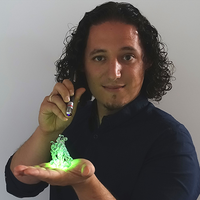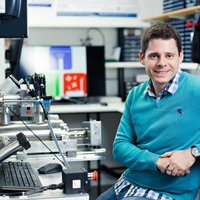The young doctorate student at the Imperial College of London (United Kingdom) Talib Alhinai has been working on a concept that could revolutionize the very traditional construction sector since 2009: versatile and autonomous flying robots capable of printing structures in 3D at scale while in flight. Thanks to this doubly innovative proposal, Alhinai has been recognized as one of MIT Technology Review, Spanish edition´s Innovators Under 35 Europe 2017. On the one hand, unlike other recreational drones or others focused on supervision, security or remote image capture, Alhinai´s devices are designed to be resistant to physical contact and are more stable and robust, as well as extremely precise. To achieve this result, this young innovator has equipped his drones with a stabilization system which allows them to approach objects without experiencing turbulence while suspended in midair. On the other hand, the ability to print in 3D while hovering is an important breakthrough as compared to traditional, stationary printers. Existing printers compatible with materials like cement are very bulky, difficult to install in situ and offer a very limited range of movement.
Alhinai´s construction drones would work as a hive, coordinating their movements in response to an emergency signal and automatically managing the construction of any structure. Just as worker bees construct honeycombs and swallows build edible nests, 3D drones deposit layers of material, one atop another, to produce structures through additive printing techniques.
Long term, this young researcher envisions his robots being sent to dangerous and remote areas requiring immediate disaster relief, like earthquake epicenters and flooded regions. Alhinai´s objective is for his machines to construct emergency shelters or perform infrastructure repairs in record time.
Completion of the development of these builder drones would allow us to dream of hives able to gather and make use of local materials autonomously to build structures, like shelters in Antartica or, why not?, colonies on Mars – that great, unfulfilled promise of the Space Age. Though, like the majority of predictions of major technological advances, its creator does not expect these to be achieved for "some 40 years."
The building material Alhinai´s drones use is expandable polyurethane foam, which is already used in the construction sector, in particular as insulation. The material is deposited in liquid format and dries and expands to 25 times its original size on contact with the air. With his current prototype design, his team has constructed one meter high columns and even a dome printed atop an inflatable semi-spherical base one and a half meters in diameter.
Short term, as the technological development progresses, Alhinai will continue to focus on applications with the greatest potential to reach the market quickly, like monitoring, surveying and infrastructure repair tasks. His drones could plug gas pipeline leaks, repaint large ships and bridges, apply anti-rust treatments to oil rigs and fix potholes, amongst other uses.
This strategic direction was a result of Alhinai´s success in the UAE Drones for Good Award competition – "the drone world´s Champion´s League title", which he won in 2016 with his flying repair robot, Buildrone. Currently, the researcher is working on adapting his services to meet the requirements of two industrial partners: a steel manufacturer in Spain with a large pipeline leak repair project, and a renewable energy company in the United States, which wants to make use of Alhinai´s drones for cleaning solar panels. "There is a need for drones to perform certain dangerous repairs to reduce the risks faced by human operators," Alhinai points out.
"Automated, robotic construction is the future of new urban development and of deep space exploration," highlights the Living Lab project leader from the Changing Places research group at the MIT Media Lab (US) and jury member for the Innovators Under 35 Europe 2017, Luis Alonso. For this reason, he describes Alhinai´s initiative as "a long-term project with the potential to change the world."
By Elena Zafra
Translation: Teresa Woods




